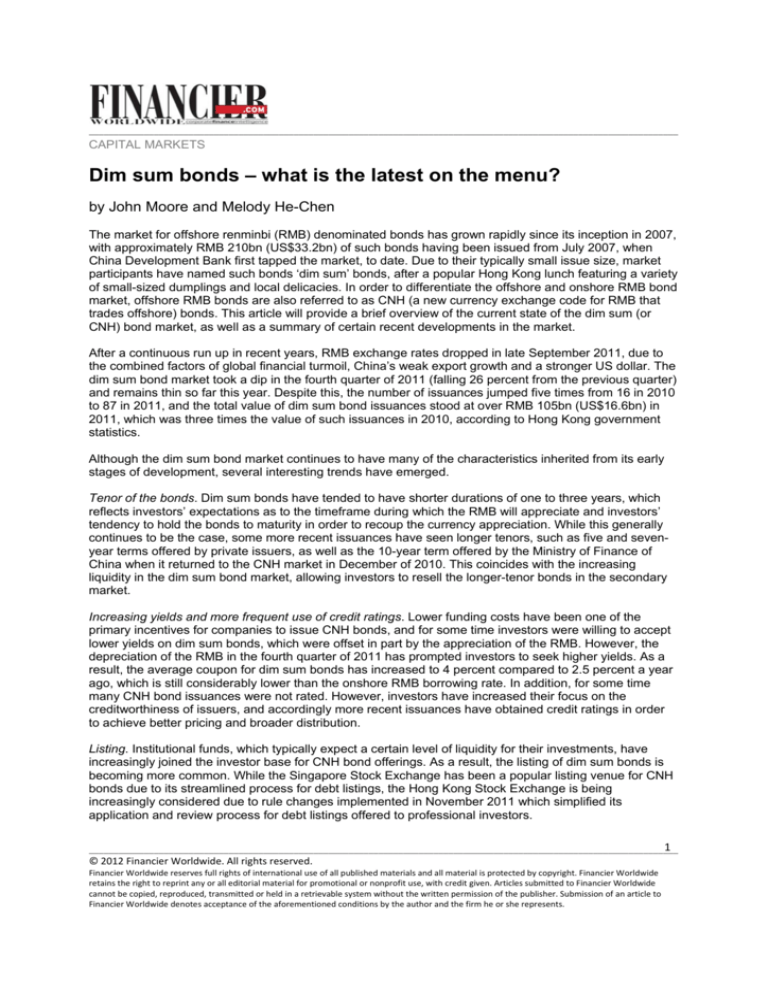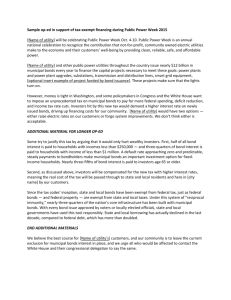
______________________________________________________________________________________________________________________
CAPITAL MARKETS
Dim sum bonds – what is the latest on the menu?
by John Moore and Melody He-Chen
The market for offshore renminbi (RMB) denominated bonds has grown rapidly since its inception in 2007,
with approximately RMB 210bn (US$33.2bn) of such bonds having been issued from July 2007, when
China Development Bank first tapped the market, to date. Due to their typically small issue size, market
participants have named such bonds ‘dim sum’ bonds, after a popular Hong Kong lunch featuring a variety
of small-sized dumplings and local delicacies. In order to differentiate the offshore and onshore RMB bond
market, offshore RMB bonds are also referred to as CNH (a new currency exchange code for RMB that
trades offshore) bonds. This article will provide a brief overview of the current state of the dim sum (or
CNH) bond market, as well as a summary of certain recent developments in the market.
After a continuous run up in recent years, RMB exchange rates dropped in late September 2011, due to
the combined factors of global financial turmoil, China’s weak export growth and a stronger US dollar. The
dim sum bond market took a dip in the fourth quarter of 2011 (falling 26 percent from the previous quarter)
and remains thin so far this year. Despite this, the number of issuances jumped five times from 16 in 2010
to 87 in 2011, and the total value of dim sum bond issuances stood at over RMB 105bn (US$16.6bn) in
2011, which was three times the value of such issuances in 2010, according to Hong Kong government
statistics.
Although the dim sum bond market continues to have many of the characteristics inherited from its early
stages of development, several interesting trends have emerged.
Tenor of the bonds. Dim sum bonds have tended to have shorter durations of one to three years, which
reflects investors’ expectations as to the timeframe during which the RMB will appreciate and investors’
tendency to hold the bonds to maturity in order to recoup the currency appreciation. While this generally
continues to be the case, some more recent issuances have seen longer tenors, such as five and sevenyear terms offered by private issuers, as well as the 10-year term offered by the Ministry of Finance of
China when it returned to the CNH market in December of 2010. This coincides with the increasing
liquidity in the dim sum bond market, allowing investors to resell the longer-tenor bonds in the secondary
market.
Increasing yields and more frequent use of credit ratings. Lower funding costs have been one of the
primary incentives for companies to issue CNH bonds, and for some time investors were willing to accept
lower yields on dim sum bonds, which were offset in part by the appreciation of the RMB. However, the
depreciation of the RMB in the fourth quarter of 2011 has prompted investors to seek higher yields. As a
result, the average coupon for dim sum bonds has increased to 4 percent compared to 2.5 percent a year
ago, which is still considerably lower than the onshore RMB borrowing rate. In addition, for some time
many CNH bond issuances were not rated. However, investors have increased their focus on the
creditworthiness of issuers, and accordingly more recent issuances have obtained credit ratings in order
to achieve better pricing and broader distribution.
Listing. Institutional funds, which typically expect a certain level of liquidity for their investments, have
increasingly joined the investor base for CNH bond offerings. As a result, the listing of dim sum bonds is
becoming more common. While the Singapore Stock Exchange has been a popular listing venue for CNH
bonds due to its streamlined process for debt listings, the Hong Kong Stock Exchange is being
increasingly considered due to rule changes implemented in November 2011 which simplified its
application and review process for debt listings offered to professional investors.
1
______________________________________________________________________________________________________________________
© 2012 Financier Worldwide. All rights reserved.
Financier Worldwide reserves full rights of international use of all published materials and all material is protected by copyright. Financier Worldwide
retains the right to reprint any or all editorial material for promotional or nonprofit use, with credit given. Articles submitted to Financier Worldwide
cannot be copied, reproduced, transmitted or held in a retrievable system without the written permission of the publisher. Submission of an article to
Financier Worldwide denotes acceptance of the aforementioned conditions by the author and the firm he or she represents.
______________________________________________________________________________________________________________________
Credit enhancement. In the early stages of the development of the CNH market, many plain vanilla dim
sum bonds, which were offered primarily by Chinese financial institutions, relied entirely on the credit of
the issuer and offered nothing in the form of credit enhancement. However, as the market continued to
develop, more complicated structures emerged with various forms of credit enhancement, including
guarantees from parent companies or operating subsidiaries, letters of credit from third-party financial
institutions, letters of support and keep-well agreements. These structures are typically used when the
issuers are either special purpose vehicles or non-operating subsidiaries where the real credit comes from
the Chinese operations. While such letters of support or keep-well structures do not provide the same
level of credit support as guarantees, they do eliminate an extra hurdle under the guarantee structures,
which requires Chinese entities providing guarantees to offshore entities to obtain approval from the State
Administration of Foreign Exchange (SAFE).
Covenant packages. With a greater supply of CNH bonds in the market and a wider range of issuers of
differing credit quality, investors have started looking more closely at what is under the dumpling skin. As
a result, covenant packages have become increasingly tighter. For example, covenant packages in the
early CNH high-yield issuances typically included only a negative pledge coupled with certain financial
maintenance covenants, which were considerably lighter than traditional US dollar high-yield bond
covenant packages. Recently, the market has seen CNH high-yield packages which more closely
resemble US dollar high-yield style covenants. Some of these covenant packages have included the
granting of security over an interest reserve bank account, which is not typical in US dollar high-yield
covenant packages. Covenants for investment grade issuances have also been enhanced with new
additions such as change of control redemptions, restrictions on sale and leaseback and currency fallback
provisions, which allow the issuer to repay the bonds in another currency if it cannot pay in RMB. For
issuers in the middle of the credit spectrum between investment grade and high-yield, an ‘investment
grade plus’ type of covenant package has emerged. These packages typically include security given by
the issuer over an interest reserve bank account and enhanced financial covenants and cross-defaults, in
addition to the typical investment grade covenants.
Disclosure of information. Investors are also demanding more robust disclosure about the companies
issuing dim sum bonds. While the offering documents of the early stage dim sum bonds did not typically
include a section on management’s discussion and analysis (MD&A) of financial statements and related
information, issuers have increasingly included such disclosure in recent transactions.
Investor base: Although a significant portion of the investors in the CNH bond market are from Asia, the
investor base is expanding to include more European investors, as an increasing number of European
companies have tapped the CNH bond market. More recently, America Movil, a Mexican
telecommunication company, issued a dim sum bond through a US SEC-registered program, which was
the first US SEC-registered global bond in the dim sum market, expanding the reach of the product to USbased investors.
These emerging trends signal that the dim sum bond market is moving in a rational direction and
developing into a more mature market. Alongside the Chinese government’s policy to further liberalise and
internationalise its currency, the dim sum bond market is poised for continuous development. We expect
that there will be more on the menu as the market continues to evolve.
John Moore and Melody He-Chen are partners at Morrison & Foerster LLP. Mr Moore can be contacted
on +852 2585 0869 or by email: johnmoore@mofo.com. Ms He-Chen can be contacted on +852 2582
0887 or by email: mhechen@mofo.com.
2
______________________________________________________________________________________________________________________
© 2012 Financier Worldwide. All rights reserved.
Financier Worldwide reserves full rights of international use of all published materials and all material is protected by copyright. Financier Worldwide
retains the right to reprint any or all editorial material for promotional or nonprofit use, with credit given. Articles submitted to Financier Worldwide
cannot be copied, reproduced, transmitted or held in a retrievable system without the written permission of the publisher. Submission of an article to
Financier Worldwide denotes acceptance of the aforementioned conditions by the author and the firm he or she represents.











